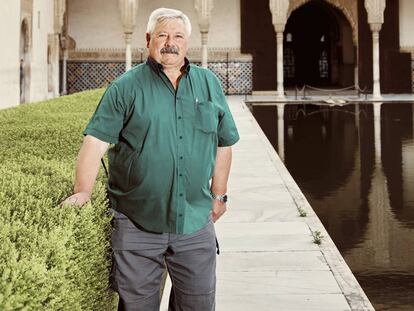Tips to take care of your indoor orchids
Maintaining your houseplant healthy involves creating a rain effect without flooding it, and letting its roots emerge from the pot
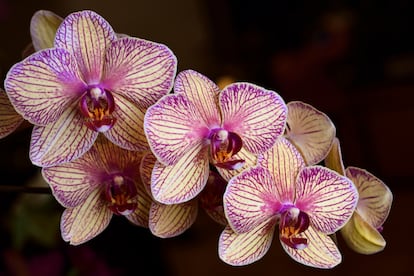
The orchid is a fascinating plant. This botanical family comprises 24,000 different species ― for now, since hundreds of new varieties are cataloged each year. The delicacy of its flowers ― a distinctive organ of a sophisticated fertilization system ― captivated Charles Darwin in the 19th century. To explain his evolutionary theory, the father of modern biology studied the peculiar strategies of the orchid based on trompe l’oeil: petals that can resemble female insects, imitate the color of the sky, adopt the texture of nectar or become hairy like the body of a bee. Cavities that are easily confused with nests and aromas that exude pheromones are just some of the techniques that this seductive plant has developed to confuse and trick pollinators and perpetuate its existence.
In its tamed state, this tropical prodigy is often seen in bridal bouquets, hotel lobbies and in party headpieces à la Dita Von Teese, Princess Diana, or Dorothy Lamour. It is also a recurring gift that conveys a delicious old-fashioned charm and is often given to a friend who is moving into a new house or office. Despite its overwhelming presence and variety ― one out of every four flowering plants in the plant kingdom is an orchid ―, this great family is reduced to barely half a dozen genera when we are talking about domestic cultivation: Dendrobium, Cattleya, Miltonia, Cymbidium, Cypripedium, Cambria… “And, above all, Phalaenopsis,” says Jesús S. Viñambres, who runs the Madrid flower shop Lufesa and graduated in Landscaping with a Master’s degree thesis dedicated to orchids. “Commercially, the genus Phalaenopsis is king,” he says of the so-called moth orchid, which comprises 80 different species.
The climbing nature of this plant in the wild answers the question of how often we have to change the soil of those we grow at home. “Never,” says Viñambres. Although there are species with root systems that sprout from the ground, most orchids are epiphytes, that is, they grow on the bark of trees, using them as a support. “In their natural state, they live without substrate,” explains the landscaper. “The root is an organ that serves to hold on to something, not to nourish itself. Their food is not in the ground.” The image we all have in mind of an orchid with upright stems is unnatural. “In their native habitats, the stems hang down, which makes it difficult to transport them and keep them as ornaments. The innate posture of the orchid is bad for our Western homes,” he jokes. For this reason, in nurseries they are placed in pots with the roots buried in a mixture of chopped pine and moss and the stems are staked so that we can enjoy their flowers face up, like carnations or geraniums. It is precisely because of their climbing nature that they develop aerial roots that grow outwards, emancipating themselves from the pot: “The roots try to cling to the pot, that’s why they come out. You don’t have to do anything about it, it’s normal.”
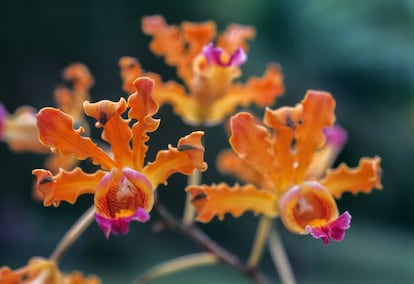
The number one lesson to keep an orchid alive is to provide it with the maximum degree of humidity, preventing the roots from getting waterlogged. “A lot of spraying, little watering,” sums up Viñambres. “We can water it by immersion or directly on the substrate, and it is better if the water is soft or rainwater. What we should never do is place a plate under the pot because that is like taking the orchid to a swamp; the roots would rot,” he adds. In their natural state, clinging to the trunk of a tree five or six meters high, they receive rainwater that drenches them and runs off. That’s why they love that we spray them. How much? “It’s never too much,” he explains.
Although it is not exclusively tropical, the orchid abounds in the regions between the two tropics, where 90% of the species are located. “There are orchids from warm, temperate and cool climates. Except for Antarctica, they live on all continents. In Europe, there are barely 200 varieties. In the Pyrenees, there are some with roots that sprout from the ground, smaller and less shiny than the exotic ones,” says the expert, who adds that, for cultivation at home, the standard domestic temperature is ideal, ensuring that it does not drop below 16ºC (60ºF): “Some tolerate up to 10ºC (50ºF), but with colder temperatures they become limp.”
The best location indoors is a place with a lot of filtered light (never direct sunlight or through glass) where there are no currents and which is not a transit area because the flowers suffer when they are touched. In addition, the florist downplays the recommendation to plant the orchids in a glass pot to allow photosynthesis. “It doesn’t matter if it is planted in a transparent or opaque pot, the photosynthesis that the orchid performs through the roots barely reaches 2% of the total.”
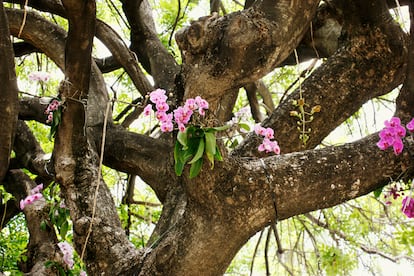
The Phalaenopsis flowers once a year and the flower lasts between one and six months. Once it falls off, the stem can be cut, but Viñambres recommends doing so two centimeters above the second-closest bud to the root. Over time, a new floral rod will emerge from this bud and, if it does not flower, the trick to stimulate it is to cause a thermal contrast by moving the plant to a cooler and more humid place, such as a bathroom with natural light. “Once the stem starts to grow, there is no going back: we can take it back to the office or the living room because a new flower is on the way,” he says.
Along with the plasticity of its flower ― there are some in the shape of a star, a spider, a dove, a heart, a hummingbird, a skull, a monkey, a naked little man, a tiger, a baby in a pram ―, the orchid has a prodigious palette of colors.“There are species of all colors,” says Marta de la Fuente, from the El Florero florist in Gijón, in northern Spain. “From the purest white to fuchsia, lilac, cream, all shades of pink, purple, orange, red, yellow, pistachio….” They can be smooth but also speckled, spotted, striped, or with patterns reminiscent of leopard print or tie dye. “Superman blue and black are the only two colors that do not exist in natural orchids,” reveals Viñambres. “For this reason, in the Netherlands they dye the white ones with vegetable aniline, an organic dye that achieves flowers of any imaginable shade,” adds De la Fuente.
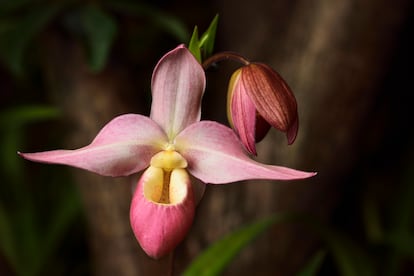
The vanilla that flavors ice creams and desserts is the essence of an orchid pod. But not everything is sweet-smelling. “Some species exhale fetid aromas of sweat, urine, rotten meat or wet cat to attract insects,” says Viñambres. This reminds us that the mission of a flower is never to please the human being, no matter how much we may show them off in our living room, office or bridal bouquet.
Sign up for our weekly newsletter to get more English-language news coverage from EL PAÍS USA Edition
Tu suscripción se está usando en otro dispositivo
¿Quieres añadir otro usuario a tu suscripción?
Si continúas leyendo en este dispositivo, no se podrá leer en el otro.
FlechaTu suscripción se está usando en otro dispositivo y solo puedes acceder a EL PAÍS desde un dispositivo a la vez.
Si quieres compartir tu cuenta, cambia tu suscripción a la modalidad Premium, así podrás añadir otro usuario. Cada uno accederá con su propia cuenta de email, lo que os permitirá personalizar vuestra experiencia en EL PAÍS.
¿Tienes una suscripción de empresa? Accede aquí para contratar más cuentas.
En el caso de no saber quién está usando tu cuenta, te recomendamos cambiar tu contraseña aquí.
Si decides continuar compartiendo tu cuenta, este mensaje se mostrará en tu dispositivo y en el de la otra persona que está usando tu cuenta de forma indefinida, afectando a tu experiencia de lectura. Puedes consultar aquí los términos y condiciones de la suscripción digital.
More information
Últimas noticias
There is as much life left to discover on planet Earth as that which is already known
Dozens presumed dead, around 100 injured in fire at Swiss Alps bar during New Year’s celebration
Is porn for women different from conventional porn? We spoke to those who make it
Cartagena de Indias is sinking: What can the city do to mitigate it?
Most viewed
- Reinhard Genzel, Nobel laureate in physics: ‘One-minute videos will never give you the truth’
- David King, chemist: ‘There are scientists studying how to cool the planet; nobody should stop these experiments from happening’
- Oona Chaplin: ‘I told James Cameron that I was living in a treehouse and starting a permaculture project with a friend’
- Sinaloa Cartel war is taking its toll on Los Chapitos
- The Interoceanic Train, the Mexican alternative to the Panama Canal

